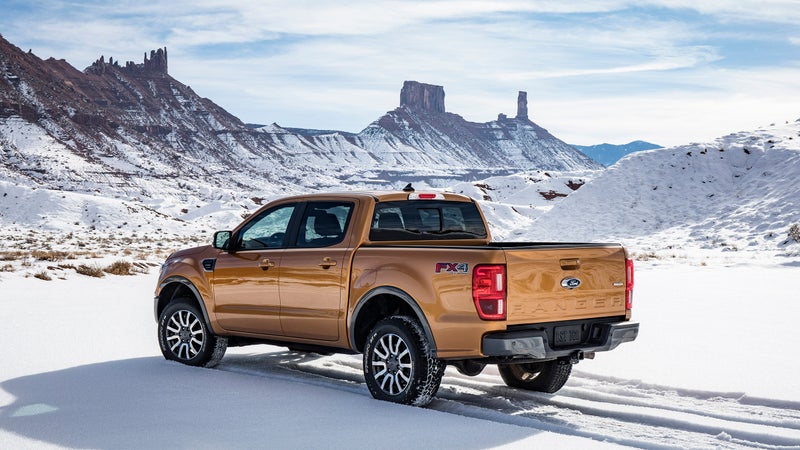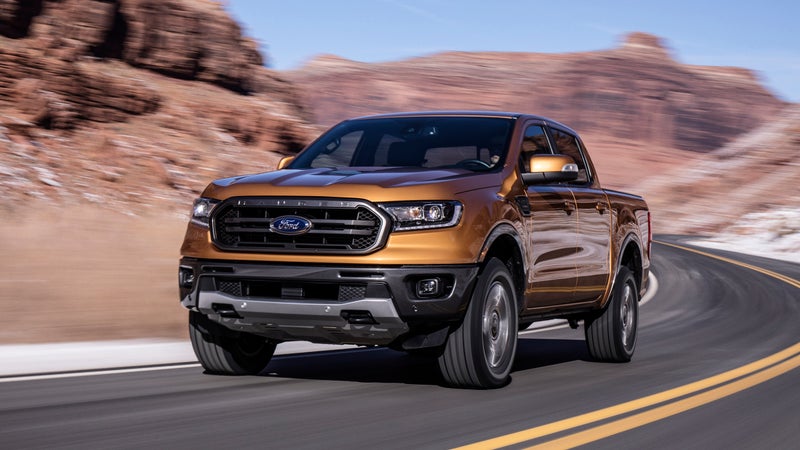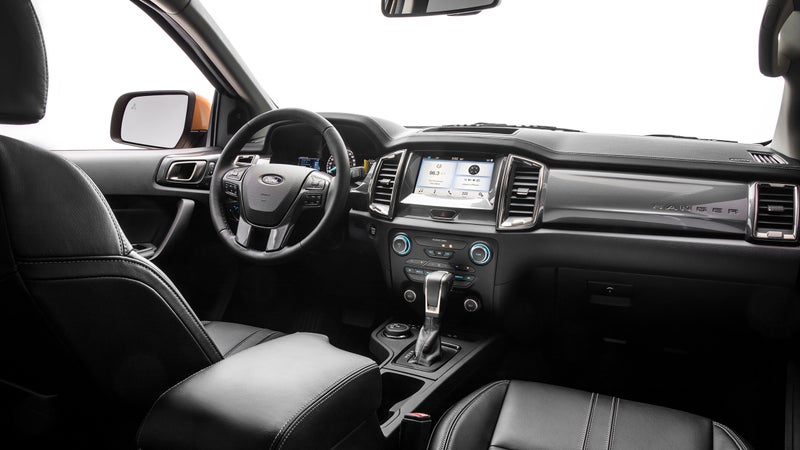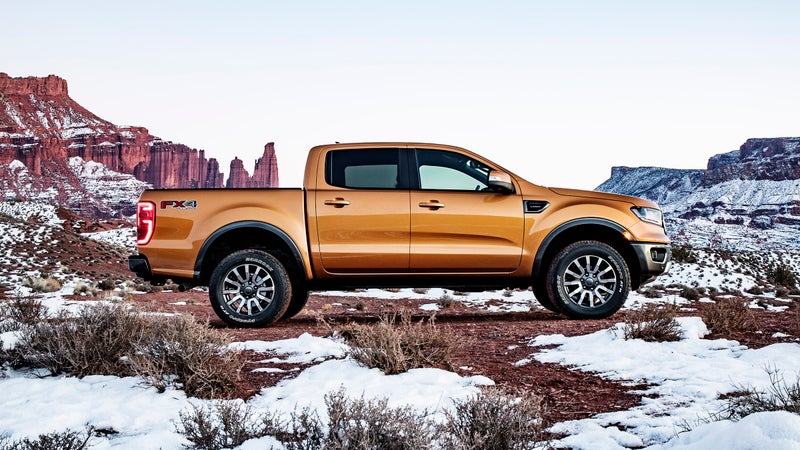Full-size trucks are too large. But until now, midsize trucks have been pretty disappointing. I think the new Ford Ranger changes that. (Mine arrives later this month.) Here’s why it’s my choice over any other truck available right now.
A Proven Package
When you buy a vehicle, you aren’t just buying a 0-to-60 time or a fuel-economy figure. You’re paying for the sum total of knowledge an automaker has been able to apply to every last facet of a vehicle’s construction.
This Ranger may be new to the United States, but it has been for sale in markets like Australia, where it was originally developed, since 2011. The version that’s going on sale here benefits from that subsequent eight years of experience with the platform, and it has been upgraded accordingly.
A few years ago, a group of colleagues and I drove a fleet of modified 4x4s across the Simpson Desert, completing what’s considered one of the most challenging off-road trips in the world. The vehicle that performed the best? The same Ford Ranger that’s going to be in my driveway in a couple of weeks. I plan to buy it from Ford when the loan period is up. I know it works, I know what it’s capable of, and I know how to get the most out of it.
Not only has my new truck benefited from the usual million miles or so of product testing that’s put into any new vehicle, but it’s also had eight years of hundreds of thousands of drivers around the world using it hard, breaking it, and telling Ford what went wrong. And that knowledge base doesn’t just exist in Ford’s collective mind but also in the heads of thousands of enthusiasts on the Internet and hundreds of independent tuners and aftermarket businesses.

A Modern Motor
The Ranger’s little 2.3-liter turbocharged four cylinder is competing against 3.5- and 3.6-liter V-6’s from Toyota and General Motors, yet with 310 pound-feet, it develops more torque than either. And where the V-6 competition was developed for boring midsize sedans, then dropped into trucks without any real modification, Ford has taken a motor developed for some seriously kickass performance cars (the Focus RS and the Mustang EcoBoost) and spent a ton of time reengineering it for truck duty.
You’ll be able to feel that while driving. Where the V-6 competition develops power very high in the rev range, and are thrashy and frustrating to use in trucks as a result, the Ford’s power kicks in down low, where a truck’s power band belongs.
Ford’s turbocharger gives the Ranger one other big advantage: unlike the naturally aspirated competition, forcing air into the motor means it won’t lose performance at altitude. That’s important here in the Rocky Mountains, where both highways and off-road trails will take you above 10,000 feet.
The Best Transmission
The ten-speed automatic in the Ranger is shared with vehicles like the Ford F-150 Raptor and the Chevy Camaro ZL1. In my opinion, it’s the best transmission available in any vehicle right now. It shifts incredibly quickly, seems to always predict the right gear it needs to be in (quite the feat with ten to choose from), and all those speeds help maximize both fuel economy and performance. It’s proven to be reliable, too.

Off-Road Numbers That Matter
All the speeds in the Ranger’s transmission, plus well-chosen final-drive and differential gearing, combine to create a first-gear, low-range crawl ratio of 47.1:1. In comparison, the Tacoma’s best number is 36.1:1, and the Chevy Colorado ZR2 only manages 41.39:1. So, all other things being equal, the Ranger will be able to climb steeper obstacles, and descend steep slopes with more control and safety.
All four-wheel-drive Rangers have an approach angle (the maximum angle of an obstacle you can drive onto without scraping) of 28.7 degrees, a breakover (what you can drive over) of 21.5 degrees, and a departure angle (what you can drive off) of 25.4 degrees.
The cheapest 4WD, four-door Tacoma is slightly better on approach, with 29 degrees, but starts falling behind on breakover (21 degrees) and departure (23 degrees). You can boost those numbers by spending up to more expensive trim levels.
An equivalent 4WD, four-door Chevy Colorado or GMC Canyon has an approach angle of just 17.1 degrees, a breakover of just 18.6 degrees, and a departure of 22.2 degrees. But again, if you have a fat wallet, you can buy better numbers.
How do these trucks compare to the not-yet-released 2020 Jeep Gladiator? Well, in Rubicon trim, the Gladiator can be spec’d up to an incredible 77.2:1 crawl ratio. That trim’s approach is an equally incredible 43.6 degrees. But even in that tallest configuration, which comes with 33-inch tires, its breakover is just 20.3 degrees and its departure is 26 degrees. And that Gladiator Rubicon is likely to cost at least $60,000. The Ranger’s numbers start on the base 4WD model, which costs just $28,460.
It Really Tows and Hauls
One of the problems with midsize trucks has always been that you give up a lot of your ability to tow or haul heavy loads, in comparison to the full-size alternatives. But with best-in-class numbers, the Ranger makes up as much of that gap as possible. With a maximum towing capacity of 7,500 pounds and a max payload (what you can put in the bed) of 2,128 pounds, it actually has capabilities that overlap those of the larger trucks, depending on how they’re configured. Its max payload, for instance, is just 180 pounds shy of the same number for the F-150, and depending on how you configure both, the Ranger can actually tow more than some versions of its big brother.
Genuinely Good Fuel Economy
The Ranger only comes with a single engine and transmission option, that 2.3-liter turbocharged four cylinder paired with the ten-speed auto. It not only puts out better performance than the V-6 competition but also offers a better fuel economy than those models, even when they’re equipped with their base four cylinders.
According to the EPA, a two-wheel-drive Ranger returns 23 miles per gallon in a combined city/highway test cycle. Four-wheel-drive models are rated at 22 miles per gallon combined. I’ve configured mine with the FX4 package, which replaces the aerodynamic front air dam with a less efficient skid plate, so expect to lose a mile per gallon to that.
One thing I’m not excited about is the 18-gallon fuel tank. It’ll mean that my maximum fuel range will be less than 400 miles, and off-road, that range could fall by as much as half. Looks like I’d better add a couple of jerry-can holders to the rear bumper I’m planning.
FX4 Package on All Trims
Ford is taking a different approach to options than Toyota or GM. While those rival trucks require you to spend up to their most expensive trim levels in order to get parts like locking differentials and off-road shocks, Ford is offering its FX4 package as an option on any Ranger trim level. It’s even offering it on two-wheel-drive Rangers, where it’s dubbed FX2.
What does that mean? For an additional $1,295, you can add three steel, frame-mounted skid plates, a locking rear differential, better shocks, and all-terrain tires to any Ranger. That package also includes Ford’s excellent terrain-management system (which alters power delivery, stability control, and other settings to suit different terrains) and the company’s new trail-control system, which works like cruise control over the most challenging, technical off-road obstacles. All of that, I think, represents pretty extraordinary value.

A Comfortable Interior
In the Tacoma, you sit low, with your legs stretched out in front of you like you’d sit in a sports car. The Colorado’s seats lack support. In the Ranger, you sit upright, as the truck gods intended, and on seats that offer genuinely good long-distance comfort. You’ll be able to do 800-mile days in this thing without getting a sore back. Upgrade to the Lariat trim, and the Ranger is positively luxurious inside.
Easy Tuning
Another advantage of the turbocharged engine is easy, affordable tuning. With only an engine control unit reflash and premium fuel, South Carolina’s 5 Star Tuning has already gotten wheel horsepower on the Ranger up to 312 and wheel torque up to 369 pound-feet. As a note on measuring power and torque, manufacturers quote figures taken at the engine’s crank. That’s impossible to replicate without pulling the engine out of the truck, so tuners employ a rolling road, which measures performance at the wheels. Figure on a 15 percent loss from crank to wheel measurements, thanks to friction in the drivetrain.
With just that basic tune, the Ranger’s 0-to-60 time drops from 7.44 seconds stock to a very impressive 5.49 seconds. That puts it in F-150 Raptor territory. The cost of all the extra performance? Only $650.
And the Ranger has one other important feature that will make modifying it easy. See how those bumpers are entirely separate from the bodywork? Taking them off will just be a case of undoing some bolts. And fitting aftermarket off-road bumpers that add protection and clearance and allow you mount other accessories like lights and a winch won’t require cutting the truck’s bodywork. That should reduce their cost and mean you can mount the bumper closer to the body, with less stand-off distance, without sacrificing protection.

Smart Safety Features
While it’s easy to focus on sexy stuff like performance numbers and off-road ability, the reality is that all of us will log plenty of road miles in our trucks. So it’s nice to have high-tech driver-aid technologies that boost safety and make day-to-day life a little easier.
Optional on the base-trim level, and standard on the midlevel XLT and fancy Lariat, is Ford’s Co-Pilot 360 system. It includes a blind-spot information system with trailer coverage and cross-traffic alert (vital when you’re backing out of parking spaces), adaptive cruise control, a lane-keeping alert system, a collision alert system with automatic emergency braking, automatic high beams, and a rearview camera.
The Insurance Institute for Highway Safety has found that automatic emergency braking reduces rear-end collisions by 50 percent on so-equipped vehicles, and automakers have agreed to make it standard on virtually all vehicles by 2022. It’s nice to see that it’s available on all trim levels of the Ranger right now.

